Non-Human Animal Communication and Human Language
VerifiedAdded on 2023/01/18
|9
|2172
|99
AI Summary
This essay explores the communication abilities of non-human animal species and their relationship to human language. It discusses the similarities and differences between animal communication and human language, using case studies of chimpanzees trained in sign language. The essay also examines the distinctiveness of language and the factors that contribute to its development.
Contribute Materials
Your contribution can guide someone’s learning journey. Share your
documents today.

Running head: LINGUISTICS
LINGUISTICS
Name of the Student:
Name of the University:
Author note:
LINGUISTICS
Name of the Student:
Name of the University:
Author note:
Secure Best Marks with AI Grader
Need help grading? Try our AI Grader for instant feedback on your assignments.
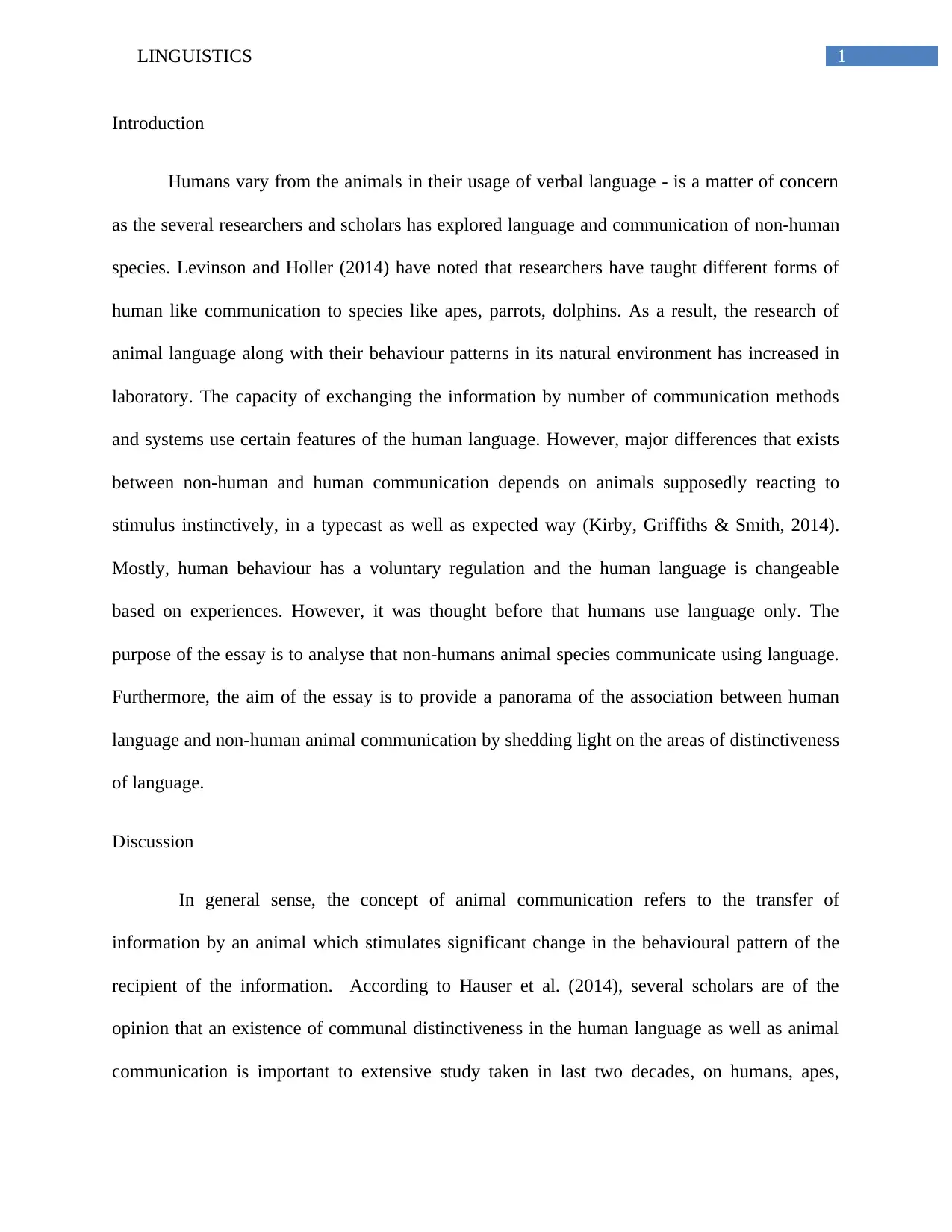
1LINGUISTICS
Introduction
Humans vary from the animals in their usage of verbal language - is a matter of concern
as the several researchers and scholars has explored language and communication of non-human
species. Levinson and Holler (2014) have noted that researchers have taught different forms of
human like communication to species like apes, parrots, dolphins. As a result, the research of
animal language along with their behaviour patterns in its natural environment has increased in
laboratory. The capacity of exchanging the information by number of communication methods
and systems use certain features of the human language. However, major differences that exists
between non-human and human communication depends on animals supposedly reacting to
stimulus instinctively, in a typecast as well as expected way (Kirby, Griffiths & Smith, 2014).
Mostly, human behaviour has a voluntary regulation and the human language is changeable
based on experiences. However, it was thought before that humans use language only. The
purpose of the essay is to analyse that non-humans animal species communicate using language.
Furthermore, the aim of the essay is to provide a panorama of the association between human
language and non-human animal communication by shedding light on the areas of distinctiveness
of language.
Discussion
In general sense, the concept of animal communication refers to the transfer of
information by an animal which stimulates significant change in the behavioural pattern of the
recipient of the information. According to Hauser et al. (2014), several scholars are of the
opinion that an existence of communal distinctiveness in the human language as well as animal
communication is important to extensive study taken in last two decades, on humans, apes,
Introduction
Humans vary from the animals in their usage of verbal language - is a matter of concern
as the several researchers and scholars has explored language and communication of non-human
species. Levinson and Holler (2014) have noted that researchers have taught different forms of
human like communication to species like apes, parrots, dolphins. As a result, the research of
animal language along with their behaviour patterns in its natural environment has increased in
laboratory. The capacity of exchanging the information by number of communication methods
and systems use certain features of the human language. However, major differences that exists
between non-human and human communication depends on animals supposedly reacting to
stimulus instinctively, in a typecast as well as expected way (Kirby, Griffiths & Smith, 2014).
Mostly, human behaviour has a voluntary regulation and the human language is changeable
based on experiences. However, it was thought before that humans use language only. The
purpose of the essay is to analyse that non-humans animal species communicate using language.
Furthermore, the aim of the essay is to provide a panorama of the association between human
language and non-human animal communication by shedding light on the areas of distinctiveness
of language.
Discussion
In general sense, the concept of animal communication refers to the transfer of
information by an animal which stimulates significant change in the behavioural pattern of the
recipient of the information. According to Hauser et al. (2014), several scholars are of the
opinion that an existence of communal distinctiveness in the human language as well as animal
communication is important to extensive study taken in last two decades, on humans, apes,
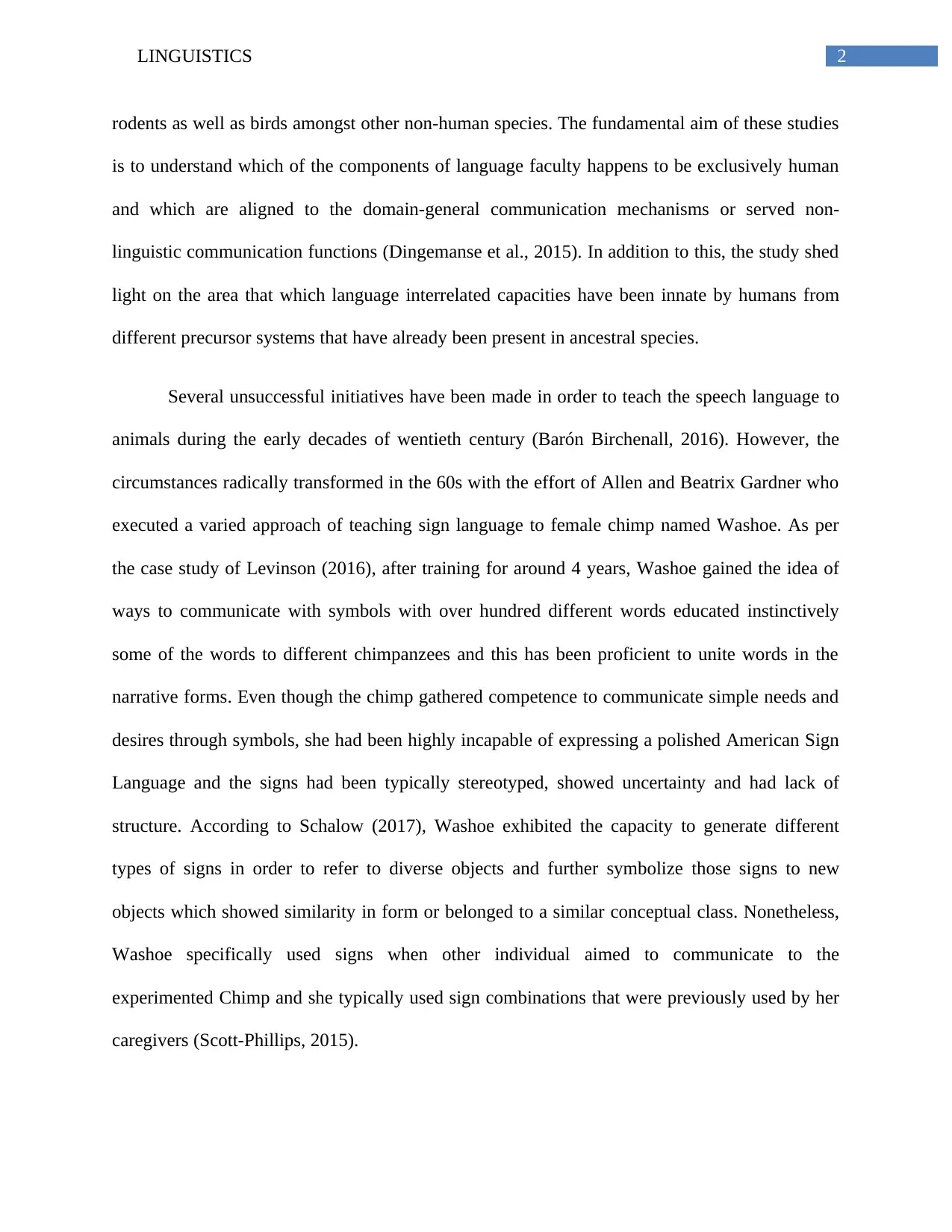
2LINGUISTICS
rodents as well as birds amongst other non-human species. The fundamental aim of these studies
is to understand which of the components of language faculty happens to be exclusively human
and which are aligned to the domain-general communication mechanisms or served non-
linguistic communication functions (Dingemanse et al., 2015). In addition to this, the study shed
light on the area that which language interrelated capacities have been innate by humans from
different precursor systems that have already been present in ancestral species.
Several unsuccessful initiatives have been made in order to teach the speech language to
animals during the early decades of wentieth century (Barón Birchenall, 2016). However, the
circumstances radically transformed in the 60s with the effort of Allen and Beatrix Gardner who
executed a varied approach of teaching sign language to female chimp named Washoe. As per
the case study of Levinson (2016), after training for around 4 years, Washoe gained the idea of
ways to communicate with symbols with over hundred different words educated instinctively
some of the words to different chimpanzees and this has been proficient to unite words in the
narrative forms. Even though the chimp gathered competence to communicate simple needs and
desires through symbols, she had been highly incapable of expressing a polished American Sign
Language and the signs had been typically stereotyped, showed uncertainty and had lack of
structure. According to Schalow (2017), Washoe exhibited the capacity to generate different
types of signs in order to refer to diverse objects and further symbolize those signs to new
objects which showed similarity in form or belonged to a similar conceptual class. Nonetheless,
Washoe specifically used signs when other individual aimed to communicate to the
experimented Chimp and she typically used sign combinations that were previously used by her
caregivers (Scott-Phillips, 2015).
rodents as well as birds amongst other non-human species. The fundamental aim of these studies
is to understand which of the components of language faculty happens to be exclusively human
and which are aligned to the domain-general communication mechanisms or served non-
linguistic communication functions (Dingemanse et al., 2015). In addition to this, the study shed
light on the area that which language interrelated capacities have been innate by humans from
different precursor systems that have already been present in ancestral species.
Several unsuccessful initiatives have been made in order to teach the speech language to
animals during the early decades of wentieth century (Barón Birchenall, 2016). However, the
circumstances radically transformed in the 60s with the effort of Allen and Beatrix Gardner who
executed a varied approach of teaching sign language to female chimp named Washoe. As per
the case study of Levinson (2016), after training for around 4 years, Washoe gained the idea of
ways to communicate with symbols with over hundred different words educated instinctively
some of the words to different chimpanzees and this has been proficient to unite words in the
narrative forms. Even though the chimp gathered competence to communicate simple needs and
desires through symbols, she had been highly incapable of expressing a polished American Sign
Language and the signs had been typically stereotyped, showed uncertainty and had lack of
structure. According to Schalow (2017), Washoe exhibited the capacity to generate different
types of signs in order to refer to diverse objects and further symbolize those signs to new
objects which showed similarity in form or belonged to a similar conceptual class. Nonetheless,
Washoe specifically used signs when other individual aimed to communicate to the
experimented Chimp and she typically used sign combinations that were previously used by her
caregivers (Scott-Phillips, 2015).
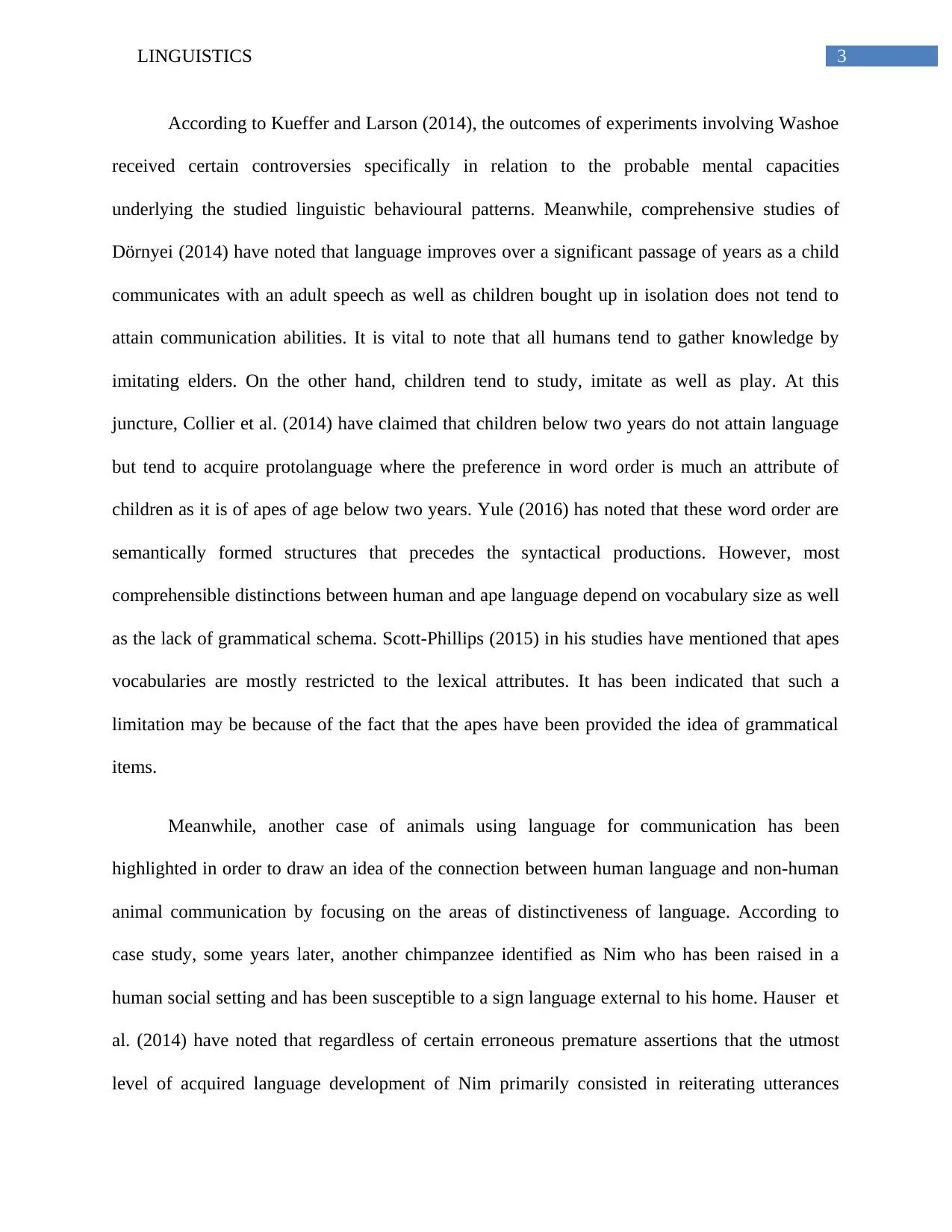
3LINGUISTICS
According to Kueffer and Larson (2014), the outcomes of experiments involving Washoe
received certain controversies specifically in relation to the probable mental capacities
underlying the studied linguistic behavioural patterns. Meanwhile, comprehensive studies of
Dörnyei (2014) have noted that language improves over a significant passage of years as a child
communicates with an adult speech as well as children bought up in isolation does not tend to
attain communication abilities. It is vital to note that all humans tend to gather knowledge by
imitating elders. On the other hand, children tend to study, imitate as well as play. At this
juncture, Collier et al. (2014) have claimed that children below two years do not attain language
but tend to acquire protolanguage where the preference in word order is much an attribute of
children as it is of apes of age below two years. Yule (2016) has noted that these word order are
semantically formed structures that precedes the syntactical productions. However, most
comprehensible distinctions between human and ape language depend on vocabulary size as well
as the lack of grammatical schema. Scott-Phillips (2015) in his studies have mentioned that apes
vocabularies are mostly restricted to the lexical attributes. It has been indicated that such a
limitation may be because of the fact that the apes have been provided the idea of grammatical
items.
Meanwhile, another case of animals using language for communication has been
highlighted in order to draw an idea of the connection between human language and non-human
animal communication by focusing on the areas of distinctiveness of language. According to
case study, some years later, another chimpanzee identified as Nim who has been raised in a
human social setting and has been susceptible to a sign language external to his home. Hauser et
al. (2014) have noted that regardless of certain erroneous premature assertions that the utmost
level of acquired language development of Nim primarily consisted in reiterating utterances
According to Kueffer and Larson (2014), the outcomes of experiments involving Washoe
received certain controversies specifically in relation to the probable mental capacities
underlying the studied linguistic behavioural patterns. Meanwhile, comprehensive studies of
Dörnyei (2014) have noted that language improves over a significant passage of years as a child
communicates with an adult speech as well as children bought up in isolation does not tend to
attain communication abilities. It is vital to note that all humans tend to gather knowledge by
imitating elders. On the other hand, children tend to study, imitate as well as play. At this
juncture, Collier et al. (2014) have claimed that children below two years do not attain language
but tend to acquire protolanguage where the preference in word order is much an attribute of
children as it is of apes of age below two years. Yule (2016) has noted that these word order are
semantically formed structures that precedes the syntactical productions. However, most
comprehensible distinctions between human and ape language depend on vocabulary size as well
as the lack of grammatical schema. Scott-Phillips (2015) in his studies have mentioned that apes
vocabularies are mostly restricted to the lexical attributes. It has been indicated that such a
limitation may be because of the fact that the apes have been provided the idea of grammatical
items.
Meanwhile, another case of animals using language for communication has been
highlighted in order to draw an idea of the connection between human language and non-human
animal communication by focusing on the areas of distinctiveness of language. According to
case study, some years later, another chimpanzee identified as Nim who has been raised in a
human social setting and has been susceptible to a sign language external to his home. Hauser et
al. (2014) have noted that regardless of certain erroneous premature assertions that the utmost
level of acquired language development of Nim primarily consisted in reiterating utterances
Secure Best Marks with AI Grader
Need help grading? Try our AI Grader for instant feedback on your assignments.
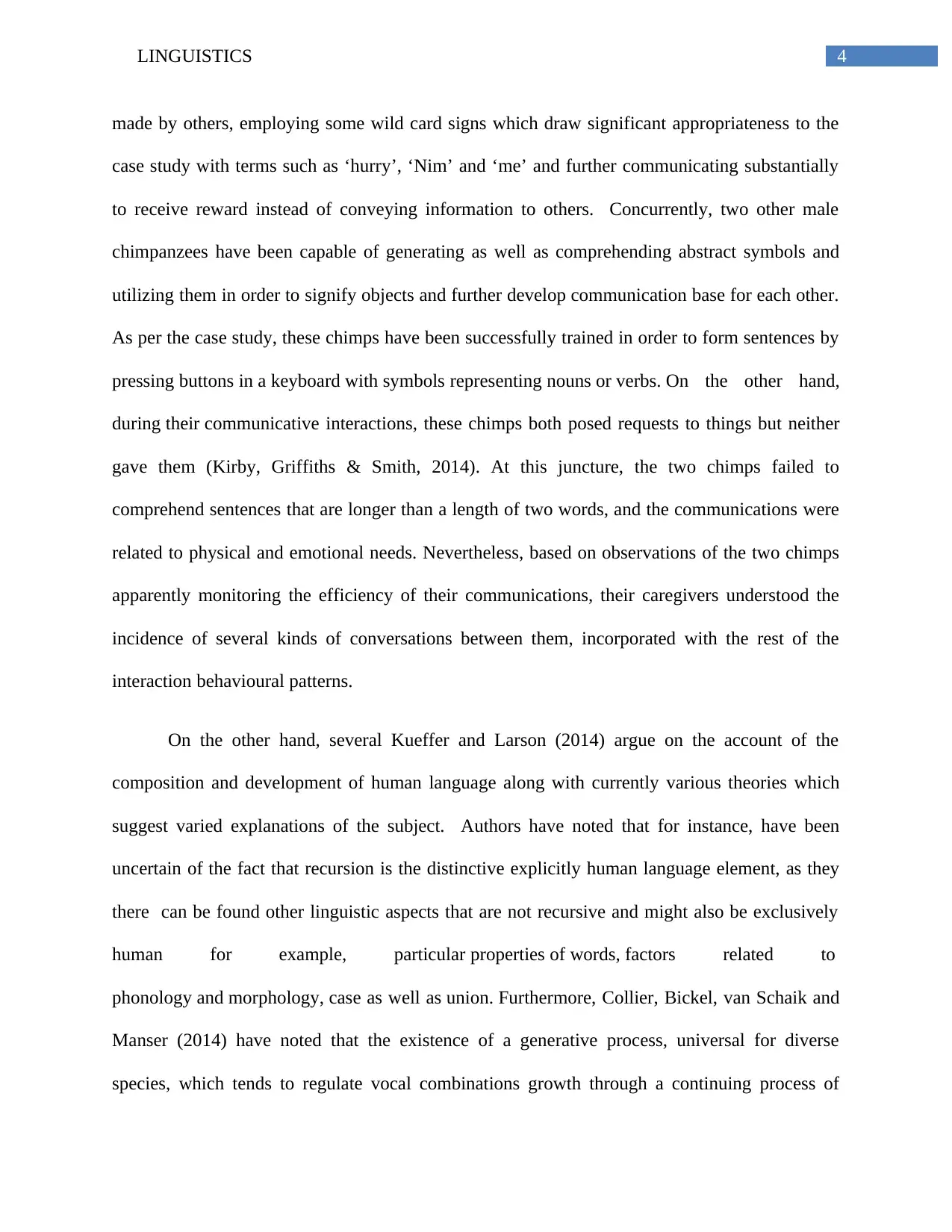
4LINGUISTICS
made by others, employing some wild card signs which draw significant appropriateness to the
case study with terms such as ‘hurry’, ‘Nim’ and ‘me’ and further communicating substantially
to receive reward instead of conveying information to others. Concurrently, two other male
chimpanzees have been capable of generating as well as comprehending abstract symbols and
utilizing them in order to signify objects and further develop communication base for each other.
As per the case study, these chimps have been successfully trained in order to form sentences by
pressing buttons in a keyboard with symbols representing nouns or verbs. On the other hand,
during their communicative interactions, these chimps both posed requests to things but neither
gave them (Kirby, Griffiths & Smith, 2014). At this juncture, the two chimps failed to
comprehend sentences that are longer than a length of two words, and the communications were
related to physical and emotional needs. Nevertheless, based on observations of the two chimps
apparently monitoring the efficiency of their communications, their caregivers understood the
incidence of several kinds of conversations between them, incorporated with the rest of the
interaction behavioural patterns.
On the other hand, several Kueffer and Larson (2014) argue on the account of the
composition and development of human language along with currently various theories which
suggest varied explanations of the subject. Authors have noted that for instance, have been
uncertain of the fact that recursion is the distinctive explicitly human language element, as they
there can be found other linguistic aspects that are not recursive and might also be exclusively
human for example, particular properties of words, factors related to
phonology and morphology, case as well as union. Furthermore, Collier, Bickel, van Schaik and
Manser (2014) have noted that the existence of a generative process, universal for diverse
species, which tends to regulate vocal combinations growth through a continuing process of
made by others, employing some wild card signs which draw significant appropriateness to the
case study with terms such as ‘hurry’, ‘Nim’ and ‘me’ and further communicating substantially
to receive reward instead of conveying information to others. Concurrently, two other male
chimpanzees have been capable of generating as well as comprehending abstract symbols and
utilizing them in order to signify objects and further develop communication base for each other.
As per the case study, these chimps have been successfully trained in order to form sentences by
pressing buttons in a keyboard with symbols representing nouns or verbs. On the other hand,
during their communicative interactions, these chimps both posed requests to things but neither
gave them (Kirby, Griffiths & Smith, 2014). At this juncture, the two chimps failed to
comprehend sentences that are longer than a length of two words, and the communications were
related to physical and emotional needs. Nevertheless, based on observations of the two chimps
apparently monitoring the efficiency of their communications, their caregivers understood the
incidence of several kinds of conversations between them, incorporated with the rest of the
interaction behavioural patterns.
On the other hand, several Kueffer and Larson (2014) argue on the account of the
composition and development of human language along with currently various theories which
suggest varied explanations of the subject. Authors have noted that for instance, have been
uncertain of the fact that recursion is the distinctive explicitly human language element, as they
there can be found other linguistic aspects that are not recursive and might also be exclusively
human for example, particular properties of words, factors related to
phonology and morphology, case as well as union. Furthermore, Collier, Bickel, van Schaik and
Manser (2014) have noted that the existence of a generative process, universal for diverse
species, which tends to regulate vocal combinations growth through a continuing process of
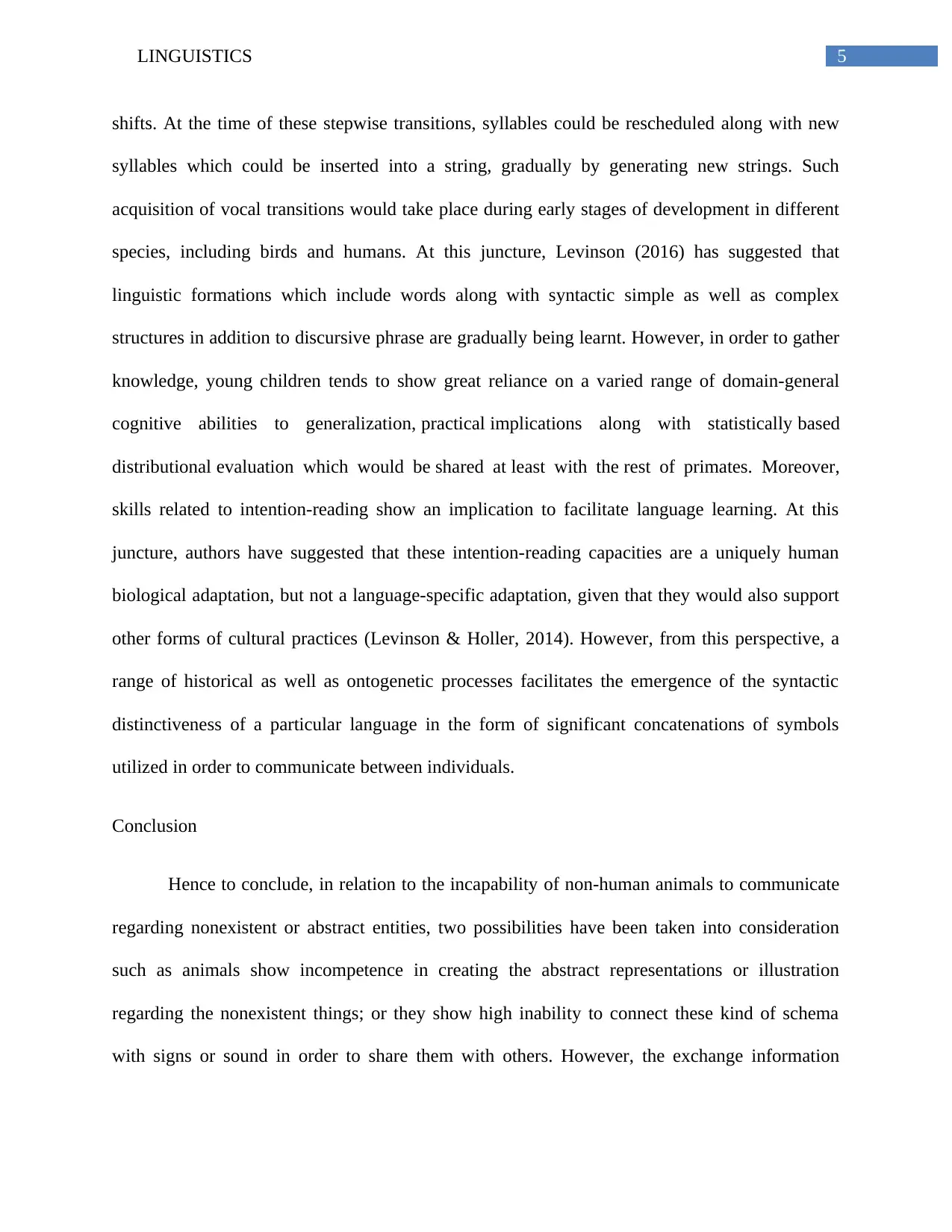
5LINGUISTICS
shifts. At the time of these stepwise transitions, syllables could be rescheduled along with new
syllables which could be inserted into a string, gradually by generating new strings. Such
acquisition of vocal transitions would take place during early stages of development in different
species, including birds and humans. At this juncture, Levinson (2016) has suggested that
linguistic formations which include words along with syntactic simple as well as complex
structures in addition to discursive phrase are gradually being learnt. However, in order to gather
knowledge, young children tends to show great reliance on a varied range of domain-general
cognitive abilities to generalization, practical implications along with statistically based
distributional evaluation which would be shared at least with the rest of primates. Moreover,
skills related to intention-reading show an implication to facilitate language learning. At this
juncture, authors have suggested that these intention-reading capacities are a uniquely human
biological adaptation, but not a language-specific adaptation, given that they would also support
other forms of cultural practices (Levinson & Holler, 2014). However, from this perspective, a
range of historical as well as ontogenetic processes facilitates the emergence of the syntactic
distinctiveness of a particular language in the form of significant concatenations of symbols
utilized in order to communicate between individuals.
Conclusion
Hence to conclude, in relation to the incapability of non-human animals to communicate
regarding nonexistent or abstract entities, two possibilities have been taken into consideration
such as animals show incompetence in creating the abstract representations or illustration
regarding the nonexistent things; or they show high inability to connect these kind of schema
with signs or sound in order to share them with others. However, the exchange information
shifts. At the time of these stepwise transitions, syllables could be rescheduled along with new
syllables which could be inserted into a string, gradually by generating new strings. Such
acquisition of vocal transitions would take place during early stages of development in different
species, including birds and humans. At this juncture, Levinson (2016) has suggested that
linguistic formations which include words along with syntactic simple as well as complex
structures in addition to discursive phrase are gradually being learnt. However, in order to gather
knowledge, young children tends to show great reliance on a varied range of domain-general
cognitive abilities to generalization, practical implications along with statistically based
distributional evaluation which would be shared at least with the rest of primates. Moreover,
skills related to intention-reading show an implication to facilitate language learning. At this
juncture, authors have suggested that these intention-reading capacities are a uniquely human
biological adaptation, but not a language-specific adaptation, given that they would also support
other forms of cultural practices (Levinson & Holler, 2014). However, from this perspective, a
range of historical as well as ontogenetic processes facilitates the emergence of the syntactic
distinctiveness of a particular language in the form of significant concatenations of symbols
utilized in order to communicate between individuals.
Conclusion
Hence to conclude, in relation to the incapability of non-human animals to communicate
regarding nonexistent or abstract entities, two possibilities have been taken into consideration
such as animals show incompetence in creating the abstract representations or illustration
regarding the nonexistent things; or they show high inability to connect these kind of schema
with signs or sound in order to share them with others. However, the exchange information

6LINGUISTICS
ability is collaborated by range of communication mechanism along with a series of animal
system which involves certain characteristics of human communication.
ability is collaborated by range of communication mechanism along with a series of animal
system which involves certain characteristics of human communication.
Paraphrase This Document
Need a fresh take? Get an instant paraphrase of this document with our AI Paraphraser
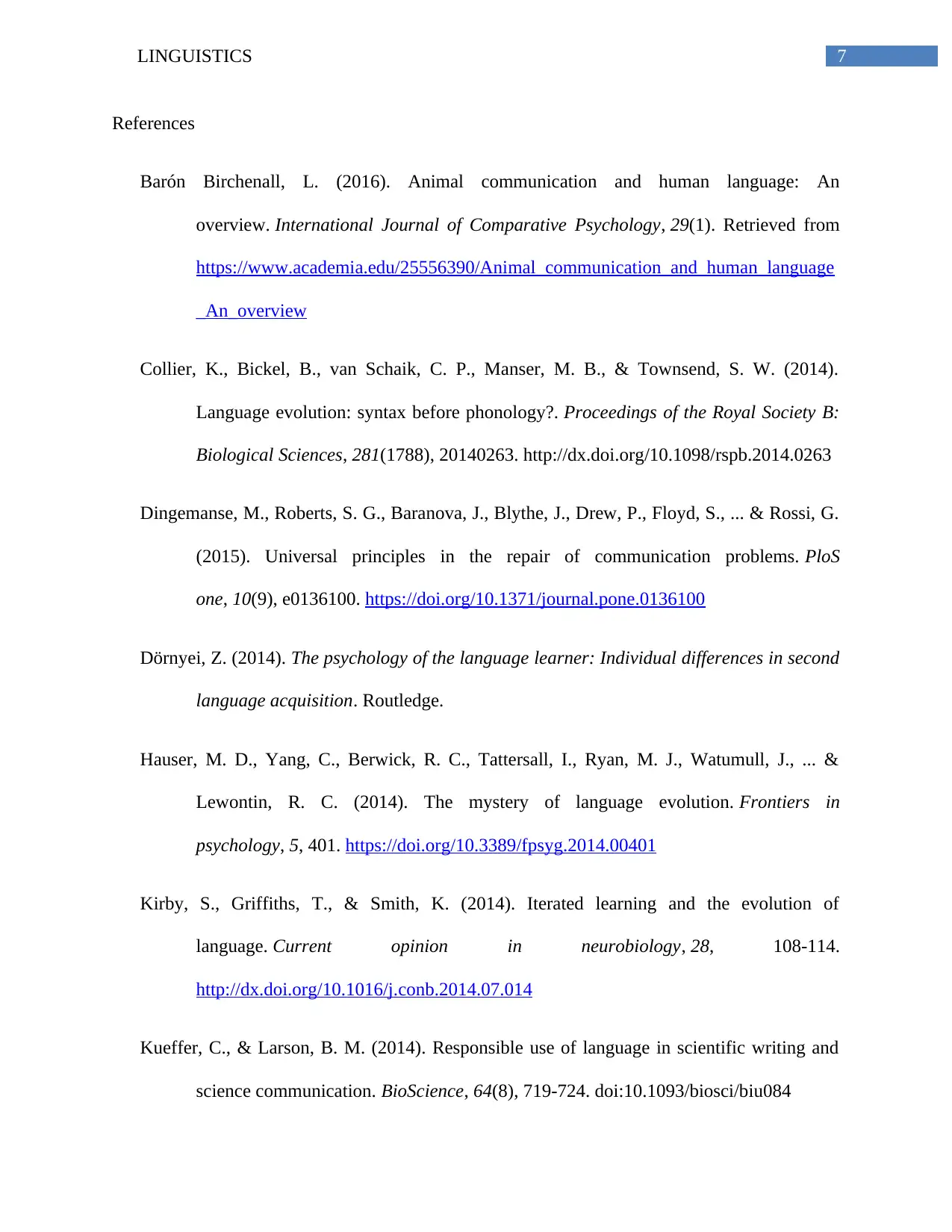
7LINGUISTICS
References
Barón Birchenall, L. (2016). Animal communication and human language: An
overview. International Journal of Comparative Psychology, 29(1). Retrieved from
https://www.academia.edu/25556390/Animal_communication_and_human_language
_An_overview
Collier, K., Bickel, B., van Schaik, C. P., Manser, M. B., & Townsend, S. W. (2014).
Language evolution: syntax before phonology?. Proceedings of the Royal Society B:
Biological Sciences, 281(1788), 20140263. http://dx.doi.org/10.1098/rspb.2014.0263
Dingemanse, M., Roberts, S. G., Baranova, J., Blythe, J., Drew, P., Floyd, S., ... & Rossi, G.
(2015). Universal principles in the repair of communication problems. PloS
one, 10(9), e0136100. https://doi.org/10.1371/journal.pone.0136100
Dörnyei, Z. (2014). The psychology of the language learner: Individual differences in second
language acquisition. Routledge.
Hauser, M. D., Yang, C., Berwick, R. C., Tattersall, I., Ryan, M. J., Watumull, J., ... &
Lewontin, R. C. (2014). The mystery of language evolution. Frontiers in
psychology, 5, 401. https://doi.org/10.3389/fpsyg.2014.00401
Kirby, S., Griffiths, T., & Smith, K. (2014). Iterated learning and the evolution of
language. Current opinion in neurobiology, 28, 108-114.
http://dx.doi.org/10.1016/j.conb.2014.07.014
Kueffer, C., & Larson, B. M. (2014). Responsible use of language in scientific writing and
science communication. BioScience, 64(8), 719-724. doi:10.1093/biosci/biu084
References
Barón Birchenall, L. (2016). Animal communication and human language: An
overview. International Journal of Comparative Psychology, 29(1). Retrieved from
https://www.academia.edu/25556390/Animal_communication_and_human_language
_An_overview
Collier, K., Bickel, B., van Schaik, C. P., Manser, M. B., & Townsend, S. W. (2014).
Language evolution: syntax before phonology?. Proceedings of the Royal Society B:
Biological Sciences, 281(1788), 20140263. http://dx.doi.org/10.1098/rspb.2014.0263
Dingemanse, M., Roberts, S. G., Baranova, J., Blythe, J., Drew, P., Floyd, S., ... & Rossi, G.
(2015). Universal principles in the repair of communication problems. PloS
one, 10(9), e0136100. https://doi.org/10.1371/journal.pone.0136100
Dörnyei, Z. (2014). The psychology of the language learner: Individual differences in second
language acquisition. Routledge.
Hauser, M. D., Yang, C., Berwick, R. C., Tattersall, I., Ryan, M. J., Watumull, J., ... &
Lewontin, R. C. (2014). The mystery of language evolution. Frontiers in
psychology, 5, 401. https://doi.org/10.3389/fpsyg.2014.00401
Kirby, S., Griffiths, T., & Smith, K. (2014). Iterated learning and the evolution of
language. Current opinion in neurobiology, 28, 108-114.
http://dx.doi.org/10.1016/j.conb.2014.07.014
Kueffer, C., & Larson, B. M. (2014). Responsible use of language in scientific writing and
science communication. BioScience, 64(8), 719-724. doi:10.1093/biosci/biu084
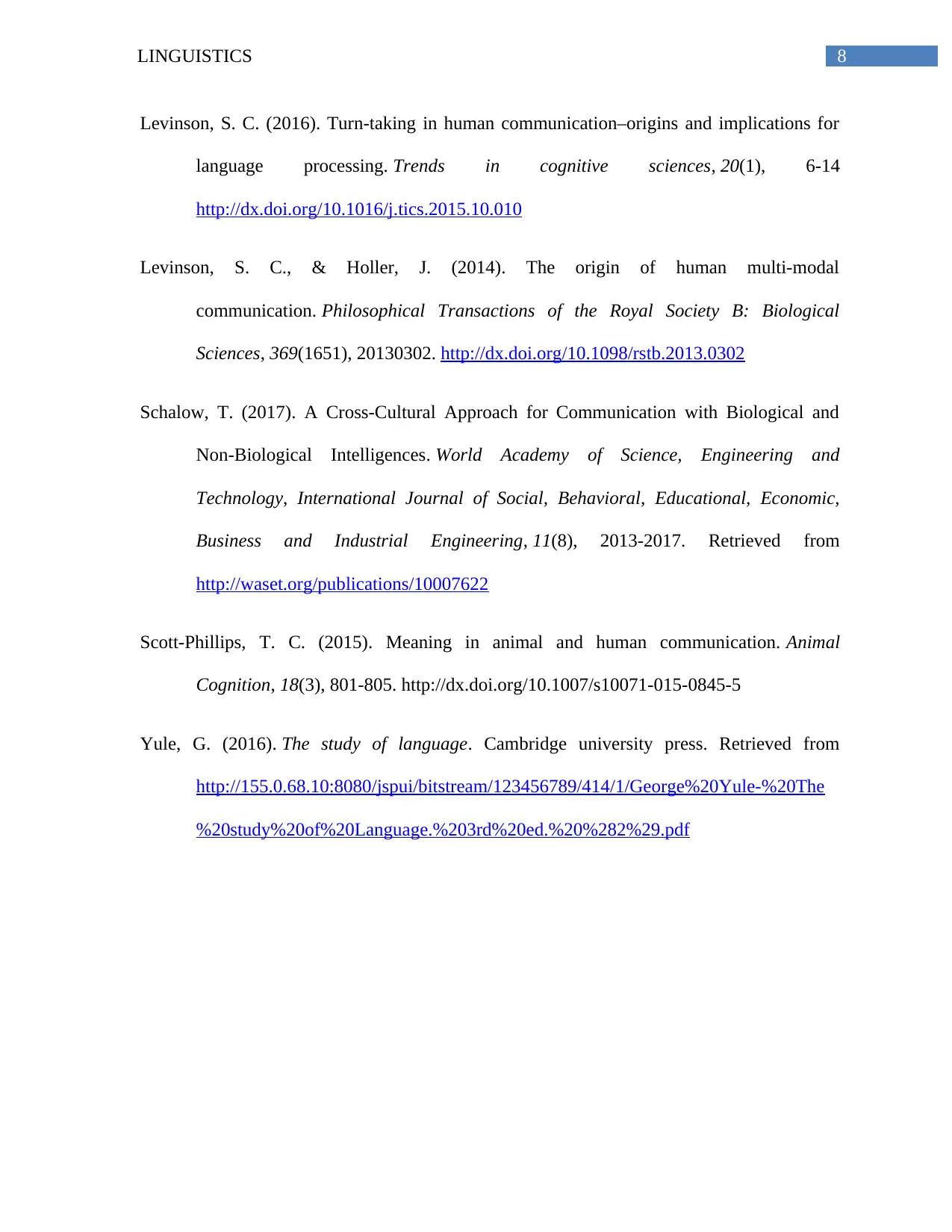
8LINGUISTICS
Levinson, S. C. (2016). Turn-taking in human communication–origins and implications for
language processing. Trends in cognitive sciences, 20(1), 6-14
http://dx.doi.org/10.1016/j.tics.2015.10.010
Levinson, S. C., & Holler, J. (2014). The origin of human multi-modal
communication. Philosophical Transactions of the Royal Society B: Biological
Sciences, 369(1651), 20130302. http://dx.doi.org/10.1098/rstb.2013.0302
Schalow, T. (2017). A Cross-Cultural Approach for Communication with Biological and
Non-Biological Intelligences. World Academy of Science, Engineering and
Technology, International Journal of Social, Behavioral, Educational, Economic,
Business and Industrial Engineering, 11(8), 2013-2017. Retrieved from
http://waset.org/publications/10007622
Scott-Phillips, T. C. (2015). Meaning in animal and human communication. Animal
Cognition, 18(3), 801-805. http://dx.doi.org/10.1007/s10071-015-0845-5
Yule, G. (2016). The study of language. Cambridge university press. Retrieved from
http://155.0.68.10:8080/jspui/bitstream/123456789/414/1/George%20Yule-%20The
%20study%20of%20Language.%203rd%20ed.%20%282%29.pdf
Levinson, S. C. (2016). Turn-taking in human communication–origins and implications for
language processing. Trends in cognitive sciences, 20(1), 6-14
http://dx.doi.org/10.1016/j.tics.2015.10.010
Levinson, S. C., & Holler, J. (2014). The origin of human multi-modal
communication. Philosophical Transactions of the Royal Society B: Biological
Sciences, 369(1651), 20130302. http://dx.doi.org/10.1098/rstb.2013.0302
Schalow, T. (2017). A Cross-Cultural Approach for Communication with Biological and
Non-Biological Intelligences. World Academy of Science, Engineering and
Technology, International Journal of Social, Behavioral, Educational, Economic,
Business and Industrial Engineering, 11(8), 2013-2017. Retrieved from
http://waset.org/publications/10007622
Scott-Phillips, T. C. (2015). Meaning in animal and human communication. Animal
Cognition, 18(3), 801-805. http://dx.doi.org/10.1007/s10071-015-0845-5
Yule, G. (2016). The study of language. Cambridge university press. Retrieved from
http://155.0.68.10:8080/jspui/bitstream/123456789/414/1/George%20Yule-%20The
%20study%20of%20Language.%203rd%20ed.%20%282%29.pdf
1 out of 9
Your All-in-One AI-Powered Toolkit for Academic Success.
+13062052269
info@desklib.com
Available 24*7 on WhatsApp / Email
![[object Object]](/_next/static/media/star-bottom.7253800d.svg)
Unlock your academic potential
© 2024 | Zucol Services PVT LTD | All rights reserved.